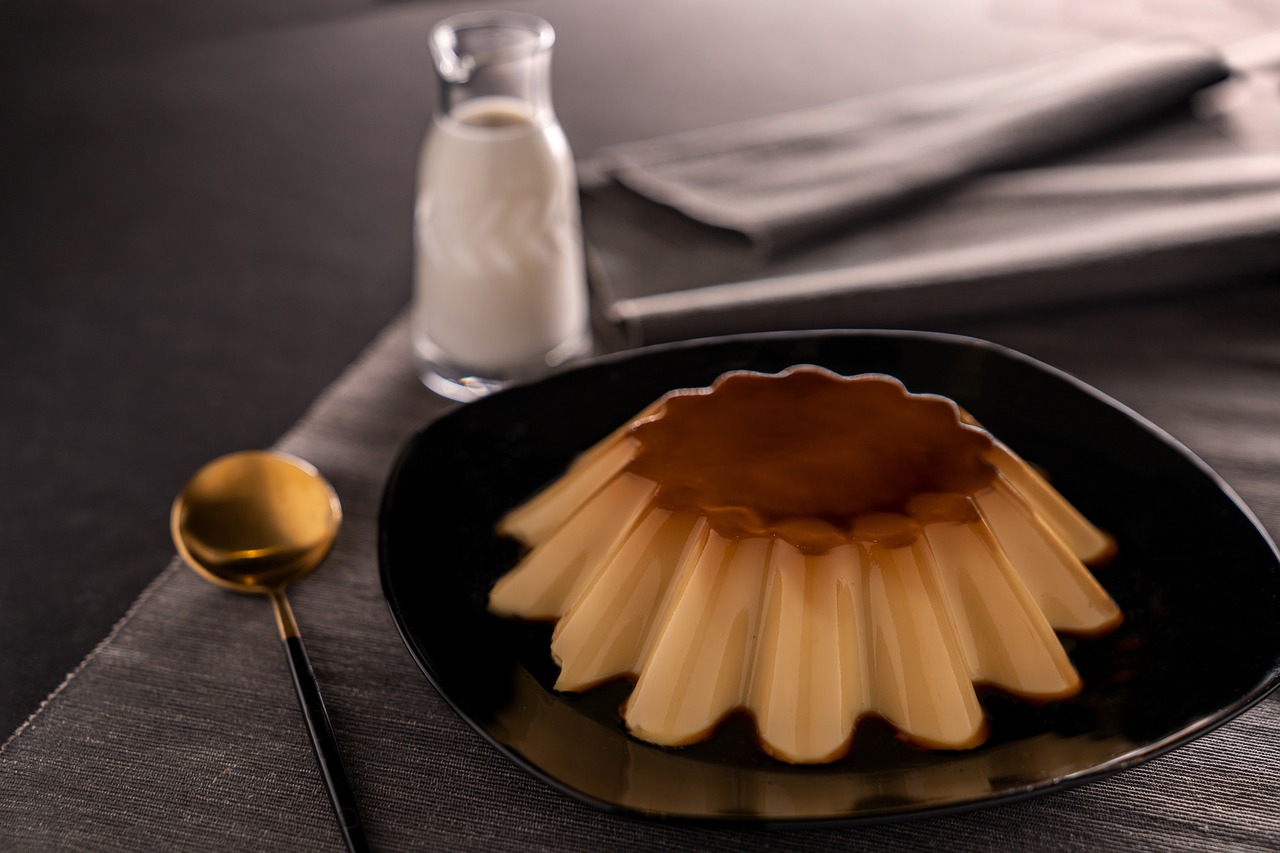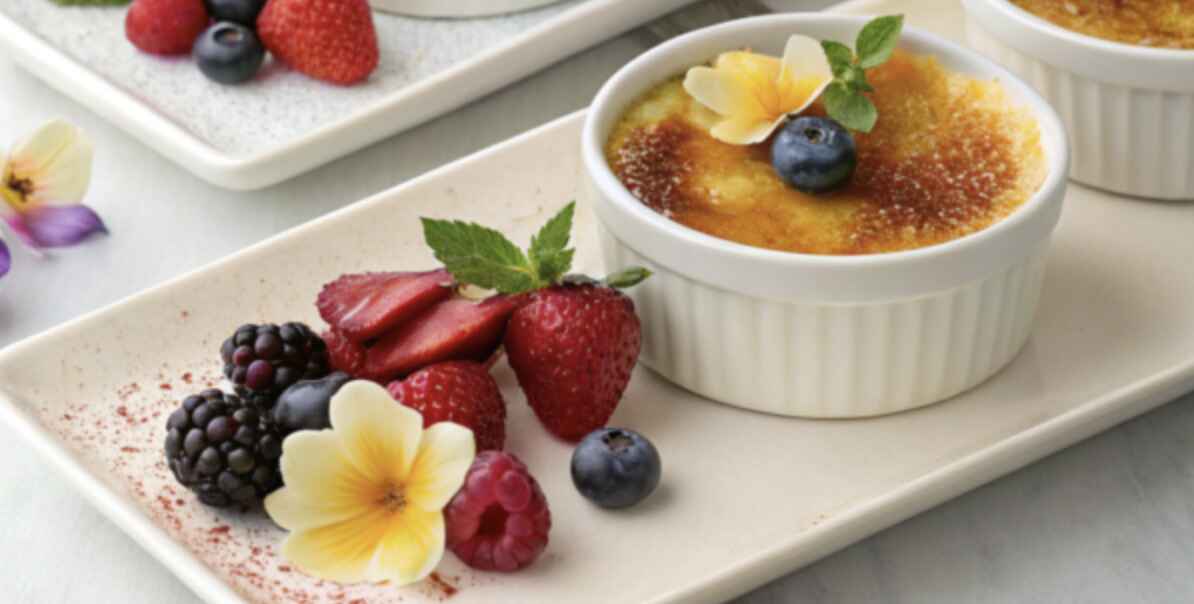Crème brûlée is famous for its crispy, caramelized sugar topping that you crack into with a spoon—it’s like dessert fireworks! On the other hand, custard is versatile and can be found in pies, tarts, or served on its own, smooth and silky like a dream.
Custard is cousin of crème brûlée. It has a long history that stretches back to Ancient Rome! The Romans were the first to discover the magical combination of eggs and milk. Over centuries, the recipe evolved, spreading across Europe and becoming the base for countless desserts.
Table of contents
Key Ingredients of Crème Brûlée vs. Custard
So, what makes crème brûlée and custard different when it comes to ingredients? Let’s break it down.
Common Ingredients in Crème Brûlée
Crème brûlée is all about simplicity. Its key ingredients include:
- Heavy cream: The base of crème brûlée is rich, thick cream, which gives it that luxurious mouthfeel.
- Egg yolks: These add richness and act as a thickening agent.
- Sugar: Used both in the custard mixture and to create that iconic caramelized top.
- Vanilla: For flavoring, though sometimes chefs add a little flair with citrus zest, coffee, or even lavender.
The secret to crème brûlée’s texture lies in its high cream-to-milk ratio, which creates a smooth, almost velvety bite.
Common Ingredients in Custard
Custard, on the other hand, is a bit more versatile. The basic ingredients are:
- Milk (or cream): While you can use cream, custard often uses milk or a combination of both, making it lighter.
- Eggs: Both the yolks and whites are typically used, though some recipes only call for yolks.
- Sugar: For sweetness.
- Flavorings: Vanilla is the classic choice, but you’ll also find custards flavored with nutmeg, cinnamon, or even chocolate.
Custard can range from light and airy to thick and dense depending on how much milk and egg you use. It’s like the chameleon of desserts, adapting to whatever dish it’s a part of.
How the Ingredients Impact Taste and Texture
Now here’s where things get interesting. Crème brûlée is undeniably rich and creamy thanks to its heavy reliance on cream. It’s meant to feel indulgent, almost like a dessert you savor slowly. The caramelized sugar top also adds a contrast of textures: creamy below, crispy above.
Custard, meanwhile, is smoother and often a bit lighter in texture. It can be served warm or cold, and its versatility means it can be adapted for a variety of dishes. Whether baked or stirred on the stovetop, custard has a comforting, almost silky quality.
“Think of crème brûlée as the classy tuxedo at a party, while custard is the cozy sweater you wear at home. Both are amazing, just in different ways.”
Why This Matters to Dessert Lovers

Here’s the deal: while both crème brûlée and custard share common ingredients like eggs, sugar, and cream, the proportions and preparation methods create entirely different experiences. This is why it’s so important to get the recipe right for each dessert. The difference in texture and flavor can be subtle, but when done properly, both desserts are absolute crowd-pleasers.
Preparation Techniques: Crème Brûlée vs. Custard
Alright, now that we know what makes crème brûlée and custard unique on paper, let’s talk about how they’re actually made. The preparation processes are where these two desserts start to carve out their separate identities. Spoiler alert: one of them is a little more high maintenance than the other.
The Method Behind Crème Brûlée
Making crème brûlée is all about precision. The process might feel a little intimidating at first, but trust me—it’s not rocket science. Here’s the step-by-step rundown:
- Heat the Cream: You start by gently warming the cream with vanilla (or other flavorings). You don’t want it to boil, just get nice and steamy.
- Whisk the Egg Yolks and Sugar: Separately, you whisk together the egg yolks and sugar until they’re pale yellow and slightly thick.
- Temper the Eggs: This is a fancy way of saying you slowly pour the warm cream into the egg mixture while whisking constantly. It’s like introducing two friends—you have to do it gradually to avoid drama (or, in this case, scrambled eggs).
- Pour into Ramekins: Once everything is combined, you pour the mixture into small ramekins (those cute little dishes you see in restaurants).
- Bake in a Water Bath: The ramekins are placed in a baking dish filled with hot water, which ensures the custard cooks gently and evenly.
- Chill and Torch: After baking, you chill the custards in the fridge until they’re set. Then comes the fun part—sprinkling sugar on top and torching it to create that crunchy caramelized layer.
“The torching step is like the grand finale of a fireworks show—dramatic, satisfying, and absolutely worth the wait.”
The Art of Making Custard
Custard, on the other hand, is a bit more forgiving (and less likely to stress you out). There are two main types of custard: baked and stirred. Here’s how both are made:
Baked Custard:
- Mix the Ingredients: Just like crème brûlée, you whisk together milk (or cream), eggs, sugar, and flavorings.
- Pour and Bake: The mixture is poured into a dish or individual ramekins and baked in a water bath.
- Check for Jiggle: You know it’s done when the custard is set but still has a slight wobble in the center—kind of like Jello.
Stirred Custard:
- Heat and Stir: The ingredients are cooked on the stovetop over low heat, stirred constantly until thickened. This type of custard is often used as a sauce or filling for other desserts (think Boston cream pie or trifle).
- Strain for Smoothness: To get that silky texture, you strain the custard to remove any cooked egg bits.
The best part about custard? No torches required, and you can enjoy it warm or cold!
Comparing Cooking Temperatures and Timing
This is where things get scientific. Crème brûlée needs to be baked at a relatively low temperature (around 300°F/150°C) to prevent it from overcooking. Custard, depending on the type, can handle slightly higher heat.
Here’s a cool tip: crème brûlée usually takes longer because of its water bath, but that bath is critical—it prevents the edges from overcooking before the center is set. Custard, especially the stirred kind, is faster since it’s cooked on the stovetop.
“It’s like baking a cake versus making a smoothie—one takes patience, and the other is quick and convenient!”
Texture and Consistency: How They Differ

When it comes to texture, crème brûlée and custard couldn’t be more different, even though they share similar ingredients. Let’s break this down.
Crème Brûlée: Silky with a Caramelized Crunch
The texture of crème brûlée is what makes it so special. Underneath that golden, caramelized sugar top is a silky-smooth custard that melts in your mouth. The contrast between the creamy custard and the crispy sugar is what sets crème brûlée apart from any other dessert.
Here’s the thing: if your crème brûlée comes out grainy or watery, it probably means the eggs curdled during cooking. That’s why you need to keep an eye on that temperature and bake it gently. The goal is to create a custard so smooth, it feels like velvet on your tongue.
Custard: Smooth, Creamy, and Versatile
Custard’s texture is a little more straightforward—it’s soft, creamy, and consistent throughout. Whether you’re making a baked custard or a stovetop version, the goal is to achieve a smooth texture without lumps or curdling.
What makes custard so versatile is its adaptability. You can thicken it more for pies and tarts or keep it lighter for sauces and puddings. It’s like the multitasker of the dessert world.
Common Problems When Making Crème Brûlée and Custard
Now, let’s talk about the not-so-glamorous side of dessert-making: mistakes. Both crème brûlée and custard can be a little tricky to get right, especially if you’re new to the kitchen. But don’t worry—I’ve got your back. Let’s troubleshoot!
Why Does Crème Brûlée Crack or Burn?
One of the most common issues with crème brûlée is over-torching the sugar. It’s super tempting to go all-out with that kitchen torch, but too much heat can burn the sugar and even crack the custard underneath.
Solution: Use a light hand when torching and move the flame around quickly to avoid burning one spot.
Another problem? Cracks in the custard itself. This happens when it’s overbaked, causing the custard to separate.
Solution: Keep an eye on the water bath, and check for doneness by giving the ramekins a gentle shake—they should jiggle slightly in the center.
Custard Troubleshooting: Why Does It Curdle or Split?
Custard, whether baked or stirred, can curdle if it’s cooked at too high a temperature. You’ll know it’s curdled when it looks grainy instead of smooth.
Solution: For baked custards, stick to low oven temperatures and don’t skip the water bath. For stovetop custards, use a double boiler or cook over very low heat while stirring constantly.
Another issue is weeping, where liquid separates from the custard after it’s cooked.
Solution: Make sure you’re using the right ratio of eggs to milk, and don’t overcook. Custard should be just set, not firm.
Why Knowing This Matters for Home Cooks
Mastering these techniques and avoiding these common problems is the key to creating desserts that wow your family and friends. Crème brûlée might take a little more effort, but that crackly sugar top is totally worth it. Custard, meanwhile, is a dependable classic that never fails to satisfy.
Nutritional Comparison Between Crème Brûlée and Custard
Let’s get real for a second: desserts like crème brûlée and custard are indulgent treats—not exactly kale smoothies. But if you’re wondering which one is the “healthier” choice or better for your lifestyle, let’s break it down.
Calorie and Sugar Content Differences
Crème brûlée is undeniably the richer of the two. Its use of heavy cream (instead of milk) gives it a higher fat content, which is why it feels so luxurious. Add the caramelized sugar topping, and you’ve got a dessert that packs a bit more of a calorie punch.
Here’s a quick comparison for a typical serving (about 1/2 cup):
- Crème Brûlée: Roughly 250–300 calories, with about 20 grams of sugar.
- Custard: Around 150–200 calories, with about 15 grams of sugar (depending on the recipe).
So, if you’re looking for a lighter option, custard might be the way to go. But hey, sometimes you just need that rich, creamy bite of crème brûlée, right?
Dietary Variations: Gluten-Free or Vegan Options
Good news: both crème brûlée and custard are naturally gluten-free, so if you’re avoiding wheat, you’re in the clear! But what about vegan or dairy-free options?
- Crème Brûlée: It’s tricky to make vegan crème brûlée since eggs and cream are central to its texture. However, you can substitute coconut cream for the heavy cream and use a plant-based egg replacer. The sugar top? That’s vegan-friendly as-is.
- Custard: Custard is much easier to adapt! You can use almond milk, oat milk, or coconut milk as a base. For thickening, cornstarch or agar-agar can replace eggs, giving you a creamy texture without any animal products.
So, if you’re hosting friends with dietary restrictions, custard might be the more versatile choice.
“Crème brûlée is a diva—it wants full-fat cream and eggs. Custard? It’s the chill, adaptable friend who’s happy with almond milk.”
Cultural Significance and Popularity

Now, let’s zoom out a bit and talk about how crème brûlée and custard have made their mark on the world. These desserts may share similar ingredients, but their cultural significance couldn’t be more different.
Why Crème Brûlée Is Synonymous with Elegance
Crème brûlée is the Audrey Hepburn of desserts—timeless, elegant, and always classy. Thanks to its French roots (and let’s be honest, the torching ritual), it’s often associated with fine dining and special occasions.
You’ll usually find crème brûlée on the menu at upscale restaurants, where it’s served in those signature ramekins with a perfect sugar crust. It’s a dessert that feels exclusive, like it’s meant to be savored slowly while sipping wine or champagne. Fancy, right?
But here’s the twist: crème brûlée’s rise to fame in pop culture also made it more accessible. From TV cooking shows to trendy cafes, it’s no longer reserved for the elite. Still, it’s the dessert you order when you want to impress someone (or yourself).
The Universal Appeal of Custard-Based Desserts
Custard, on the other hand, is more like a comfort food. Its versatility means it’s enjoyed all over the world, in a million different forms:
- In England, it’s poured over sticky toffee pudding.
- In Portugal, it’s baked into pastel de nata (those addictive custard tarts).
- In the U.S., it’s the star of pies like banana cream and Boston cream.
- And let’s not forget Asia, where egg custard is a staple in dim sum and baked buns!
Custard isn’t about being fancy—it’s about being familiar. It’s the dessert you grew up with, the kind you could make at home on a lazy Sunday afternoon. Whether it’s baked, stirred, or even frozen (hello, frozen custard!), it’s the ultimate comfort dessert.
“If crème brûlée is the little black dress of desserts, custard is your favorite pair of cozy pajamas.”
Crème Brûlée vs. Custard: Which One Should You Choose?
Now that we’ve covered the differences, you might still be wondering: Which one should I make (or order) tonight? The answer depends on a few things.
Factors to Consider: Taste Preferences and Occasions
- Go for Crème Brûlée if you’re craving something rich, indulgent, and show-stopping. It’s perfect for date nights, celebrations, or anytime you want to feel fancy.
- Pick Custard if you’re looking for something lighter, versatile, and comforting. It’s ideal for family dinners, casual gatherings, or as a base for other desserts.
Tips for Perfecting Each Dessert
Here are some pro tips to help you nail these desserts every time:
For Crème Brûlée:
- Use a kitchen torch for the sugar topping (a broiler works, but a torch gives better control).
- Let the custard chill fully before torching—it’ll set properly and make that sugar crust extra satisfying to crack.
For Custard:
- Strain your custard mixture before cooking to ensure it’s ultra-smooth.
- Stirred custard? Use low heat and stir constantly to avoid lumps.
“Remember: making desserts is like a dance. Go slow, follow the rhythm, and you’ll end up with something beautiful.”
Frequently Asked Questions About Crème Brûlée and Custard
Still curious? Let’s tackle some of the most common questions people have about these creamy delights.
Can You Substitute Custard for Crème Brûlée or Vice Versa?
Technically, you can’t swap one for the other because they’re prepared so differently. However, custard can act as a stand-in for crème brûlée in certain desserts if you skip the caramelized sugar top.Are There Healthier Alternatives for Either Dessert?
Conclusion: A Tale of Two Creamy Desserts
At the end of the day, both crème brûlée and custard are winners in their own right. Crème brûlée is the glamorous, slightly high-maintenance dessert that dazzles you with its caramelized sugar top. Custard, meanwhile, is the reliable, comforting classic that feels like a warm hug in dessert form.
So, which one will you choose? Maybe you don’t have to. After all, life is too short not to enjoy both.
“Desserts are the punctuation marks of meals—they bring everything to a sweet, satisfying close.”

